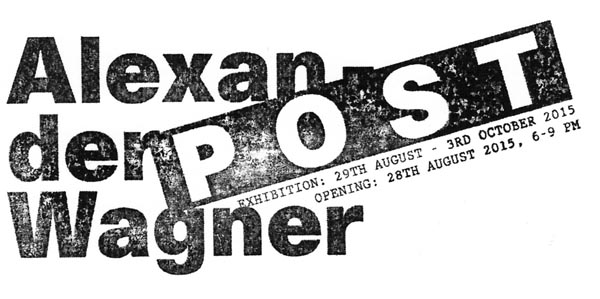New paintings all made this year are the content of 'post', Alexander Wagner's third solo exhibition at RaebervonStenglin. Each work is of the same size and portrait orientation and was made in dialogue with its companions relating conversationally to one another, their splashy demeanour and garish patterns expressing an untroubled air. Paintings made long after the purported death of painting, post-post-modernism and even post-internet, Wagner's canvases are also sculptural objects, their surface imagery unfolding their process post their own making.
To create the works the artist employed a very particular strategy: Wagner stretched a canvas over a small frame to form a 'classic' site for the picture to take place; he then painted on this before re-stretching the canvas onto a larger frame so that the previously unseen drips delineating the edges of the original image now become part of the picture. Ironically staging the site of the image within the quotation marks of its framing, each piece also undoes this distinction — the borders' vivid colours and dynamic relationship to the whole creating complex total compositions. Semi-abstract elements, stylised signs and repeated patterns meet with the risk and gestural results of the artist's performative actions. The image and its physical reality are set in constant reverberation and are compounded by self-reflexive motifs: crosses suggestive of the frame supporting the picture plane; flag-like designs that evoke other uses of canvas; eyes that denote seeing.
Wagner's paintings collate references and influences, wearing them lightly so that diverse styles find a common language on the canvas. They refer to Pop Art and to expressionism, to eclectic artists’ work and to their late place in the history of painting; but also they relate to the artist's own earlier works on paper, which in turn draw upon styles of music, architecture and functional typography as much as they cite fine art references. Like a desktop meeting place for varied documents — and similar to the ' flatbed picture plane' that Leo Steinberg discerned as Rauschenberg's key legacy — his canvases are the repositories of ideas, receptor surfaces that conflate the pictorial and the material. Yet crucially their mode of address is always as portraits, as individuals that sidestep the expectations of art history through the personable exchange between artist and canvas, canvas and viewer.
Alexander Wagner was born in 1978 in Berlin, Gemany. His solo exhibitions include ‘undundund’, Little Krimminals, Berlin (2014); Galeri Mana, Istanbul (2013); 'Alexander Wagner’, RaebervonStenglin (2010); ‘INSERT, zum zeichnerischen’, Jet, Berlin (2009); ‘mustern’, SOX, Berlin (2008); and ‘Alexander Wagner’, NBKstudio (Neuer Berliner Kunstverein), Berlin (2007). Recent group shows include ‘structures form layers, forms layer structures, layers structure forms', KM, Berlin (2014); 'Auf Zeit', Kunsthalle Bielefeld, Bielefeld; 'Warp & Weft', Spazio Cabinet, Milan (both 2013); 'Reflecting on Reflection', Galeri Mana, Istanbul and 'changing and growing', KM, Berlin (both 2012). Wagner lives and works in Berlin.



























